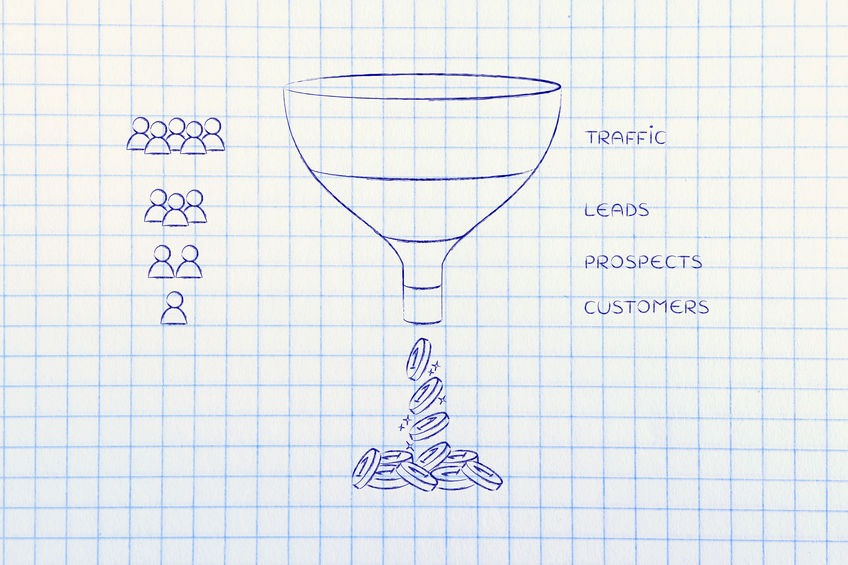Mais savez-vous comment tirer profit de ces outils pour générer des leads ? Pour contribuer activement à votre activité commerciale, ces outils doivent être associés à une stratégie webmarketing, et leur utilisation pensée de façon coordonnée.
Voici 3 exemples de « tunnels de vente » efficaces pour générer des leads avec l’aide de vos outils web.
[Rappel] Qu’est-ce qu’un « tunnel de vente » ?
Si vous avez lu notre article “Et si votre site web générait (enfin) des leads ?”, la notion de “tunnel de vente” n’a plus de secret pour vous !
Dans le cas contraire, en voici un résumé rapide :
En webmarketing, un “tunnel de vente” est un “scénario” auquel vous avez réfléchi à l’avance pour orienter vos différents contacts (physiques ou web) vers des pages clés de votre site internet, en vue de les transformer en prospects identifiés.
Il s’appuie sur 3 éléments clés :
- Un contenu attractif pour vos prospects, ou LEAD MAGNET
- Un point d’entrée permettant de les identifier, appelé LANDING PAGE
- Et une séquence email destinée à les transformer en LEADS QUALIFIÉS
Comment permet-il de “générer des leads” ?
Un tunnel de vente est construit de façon à provoquer des interactions avec vos prospects potentiels, une fois que vous les avez captés et dirigés vers votre site web : un clic, la visite d’une page clé, la soumission d’un formulaire…
Le but est de les faire passer du statut de “visiteur non identifié” à celui de “visiteur identifié” (avec un nom et un contact), puis de les transformer en “lead qualifié”.
Un “lead qualifié” est un interlocuteur avec lequel vous êtes en mesure d’initier un échange commercial, c’est-à-dire : chez qui vous avez détecté un intérêt pour votre offre, et dont vous possédez les coordonnées directes (email + téléphone).
Le scénario mis en place consiste à utiliser vos outils web de façon stratégique et coordonnée pour vous permettre de valider ces 2 points clés.
3 exemples de “tunnel de vente” web efficaces
Prenons le cas d’une entreprise (fictive) de conseil dans le domaine de l’Expérience Client.
Voici 3 exemples de scénarios qu’elle peut mettre en place pour générer des leads :
SCÉNARIO 1 – Questionnaire d’auto-évaluation
Ce scénario est l’un des plus rapides et des moins coûteux à mettre en œuvre. Idéal pour une première approche en logique “tunnel de vente”.
- LEAD MAGNET : Auto-diagnostic
Un prospect potentiel visite le site web de l’entreprise et consulte un article du blog, par exemple : “3 entreprises inspirantes en matière d’Expérience Client”. Un Call-To-Action(CTA) en bas d’article l’invite à réaliser un autodiagnostic en ligne sur le sujet. Par exemple “Évaluez la qualité de l’Expérience Client délivrée par votre entreprise”.
- LANDING PAGE : Page questionnaire
Le visiteur intéressé clique sur le CTA qui le renvoie vers un questionnaire en ligne. (Vous pouvez pour commencer créer vos questionnaires web avec un outil gratuit, comme Google Form).
La participation au questionnaire implique de renseigner des champs obligatoires pour recevoir ensuite les résultats : Nom + Adresse email, et éventuellement des champs optionnels : Fonction + Entreprise + N° de téléphone. (N’oubliez pas les mentions obligatoires RGPD )
- SEQUENCE EMAIL : Synthèse des résultats
2 jours après sa participation à l’auto-diagnostic, l’entreprise envoie par email au participant la synthèse des résultats, accompagnée d’une proposition de rendez-vous téléphonique pour commenter ces résultats et, par exemple, définir un plan d’amélioration court terme.
- QUALIFICATION DU LEAD : Prise de rendez-vous
Si le participant valide la proposition de rendez-vous téléphonique, il passe au statut de “lead qualifié” et ses coordonnées sont transmises à un commercial !
SCÉNARIO 2 – Ebook thématique
Ce scénario un peu plus long à mettre en œuvre permet d’établir progressivement la relation avec un nouveau contact identifié et de construire la légitimité de l’entreprise à ses yeux.
Découvrez les webinars KESTIO, on y aborde
tous les sujets liés à la performance commerciale avec nos experts :
Fabien Comtet, CEO
Dominique Seguin, DG
Nicolas Boissard, Directeur Marketing
- LEAD MAGNET : EBook
Une campagne Linkedin Ads diffusée sur les profils Linkedin des “Directeurs de l’Expérience Client” d’entreprises ciblées génère un flux de visiteurs qualifiés vers un Ebook au contenu attractif pour cette cible.
Par exemple, un dossier de 15 pages sur “Les champions de l’Expérience Client”.
- LANDING PAGE : Page de téléchargement
Les visiteurs intéressés sont renvoyés vers une page dédiée, qui comporte un formulaire de téléchargement avec des champs obligatoires pour recevoir ensuite le lien vers le Ebook : Nom + Adresse email, et des champs optionnels : Fonction + Entreprise + N°de téléphone. (Sans oublier les mentions obligatoires RGPD).
- SEQUENCE EMAIL : Auto-diagnostic
Email 1 – Envoyé aux personnes ayant téléchargé l’Ebook
Un premier email envoyé 2 jours plus tard les invite à réaliser un auto-diagnostic en ligne de l’Expérience Client de leur entreprise.
Le participant choisit entre 2 options :
Option 1
Recevoir la synthèse des résultats par email
Option 2
Être recontacté par téléphone pour une restitution personnalisée des résultats
Email 2 – Envoyé aux personnes ayant répondu au questionnaire en ligne
Un second email est envoyé 2 jours plus tard, contenant :
Option 1
la synthèse des résultats au format pdf avec un “Call-to-Action” (CTA) incitant à prendre rendez-vous pour un entretien gratuit.
Option 2
Une proposition de rendez-vous pour l’entretien de restitution des résultats, à l’issue duquel la synthèse lui sera envoyée.
- QUALIFICATION DU LEAD : Prise de rendez-vous
Si le participant valide la proposition de rendez-vous téléphonique, il passe au statut de “lead qualifié” et ses coordonnées sont transmises à un commercial.
SCÉNARIO 3 – Support de conférence
Comme l’illustre ce 3ème exemple, un scénario web de génération de leads peut aussi intégrer un (ou plusieurs) point(s) de contact physique(s) !
- LEAD MAGNET : Support de conférence
Le dirigeant de l’entreprise anime une conférence sur le thème “Les nouveaux enjeux de l’Expérience Client”.
A l’issue de son intervention, il invite les participants à aller télécharger le support de sa conférence.
- LANDING PAGE : Page de téléchargement
La page de téléchargement du support de conférence comporte un formulaire à remplir pour recevoir le support, avec les champs obligatoires : Nom + Adresse email, et des champs optionnels : Fonction + Entreprise + N° de téléphone.
- SEQUENCE EMAIL : Questionnaire de satisfaction
Email 1 – Envoyé à J+2 aux personnes ayant téléchargé le support
Un premier message les invite à répondre à un questionnaire de satisfaction en ligne au sujet de la conférence.
A l’issue du questionnaire, le répondant peut demander à être rappelé par un expert pour définir ses priorités en matière d’Expérience Client.
Email 2 – Envoyé à J+2 aux personnes ayant répondu au questionnaire
Si le répondant n’a pas demandé à être rappelé à l’issue du questionnaire, un nouvel email lui est envoyé 2 jours plus tard pour lui proposer à nouveau un entretien personnalisé.
- QUALIFICATION DU LEAD : Prise de rendez-vous
Si le participant valide la proposition de rendez-vous téléphonique (à l’étape 1 ou à l’étape 2 de la séquence email), il passe au statut de “lead qualifié” et ses coordonnées sont transmises à un commercial.
Chacun de ces 3 scénarios a permis à l’entreprise d’identifier de nouveaux contacts via son site internet et de transformer une partie d’entre eux en leads qualifiés qu’elle a transmis à ses commerciaux !
De plus, les chances de transformation auprès de ces prospects sont démultipliées, car :
- Ces derniers connaissent déjà l’entreprise,
- L’entreprise a acquis une certaine légitimité à leurs yeux
- Les commerciaux disposent d’informations précises sur leur profil (obtenues via le formulaire, le questionnaire et l’entretien)
De nombreuses variantes de ces scénarios sont possibles, en fonction de votre secteur d’activité, de vos offres, du profil de vos prospects et des outils marketing dont vous disposez. Commencez par déployer un 1er scénario en mode « test & learn » pour générer vos premiers leads. Vous pourrez ensuite les décliner pour chacune de vos offres et monter en puissance !
Pour développer les outils de communication votre entreprise, pensez au Webinar!
Le webinar permet de mettre en avant un contenu attractif et ainsi de valoriser l’activité de l’entreprise.
Cependant il nécessite quelques règles: dans ce webinar apprenez comment organiser un webinar qui vous génère plus de participants et de leads.





